

The "Embouchure" (ahm´-boo-shur), from the French word emboucher, meaning "to put into the mouth," refers in music to the proper way of using one's mouth, throat, and breath to produce correct sounds on a musical instrument.
The following information comes to you from the Embou-sure© book which is used by the American Band College.
Please select your instrument:
 |
 |
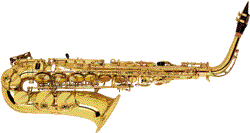 |
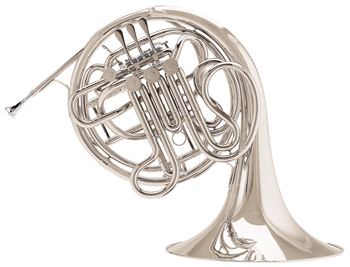 |
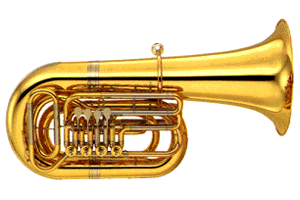 |
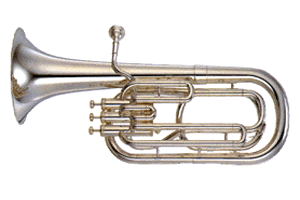 |
from an article by Larry Hudson
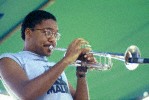 The first
thing a trumpet player needs to do, before he or she even touches lips to
mouthpiece, is to make sure to have enough breath to make a proper trumpet tone.
You must sit tall in your chair, with your feet flat on the floor. To make sure
you get enough breath, imagine that there is a piece of paper on a wall in front
of your face, and that you must be able to blow enough air through your lips
fast enough to make the paper stick to the wall!! Try it!! It really works to
learn how much "fast air" you really need!
The first
thing a trumpet player needs to do, before he or she even touches lips to
mouthpiece, is to make sure to have enough breath to make a proper trumpet tone.
You must sit tall in your chair, with your feet flat on the floor. To make sure
you get enough breath, imagine that there is a piece of paper on a wall in front
of your face, and that you must be able to blow enough air through your lips
fast enough to make the paper stick to the wall!! Try it!! It really works to
learn how much "fast air" you really need!

Take a deep breath, form the throat as if you were saying "Ho," and as you breathe out, the throat should feel cold from the "fast air."
2. "BANANA"
When you feel the fast air with an open throat, you're ready for the secret word: BANANA! Say the word "banana" four or five times. Feel how the letter "BUH" sound starts the word.
3. JUST THE "B"
Now, just form the lips into the "B" that starts the "BUH." If you do it correctly, the lips will come together in just the right way for the trumpet...not pinched, and not tight....but JUST RIGHT!! Now you know how to form the correct trumpet EMBOUCHURE!!
4. THE FIRST TONE
The next step is to couple the lip formation (the embouchure) with the instrument. Look at the pictures above to see how the mouthpiece fits comfortably on your lips. Start with "first space F", breathe the "fast air" through the "BUH", making sure that the lips remain in the "B" position (lick your lips and the mouthpiece first). Chances are, if you follow all the above instructions, you will be off on the right foot, and ready to make a GOOD TRUMPET TONE!
If you think that you don't sound like a trumpet should, or like your teacher says you should, check the following chart and try the suggested solutions. Always remember: If it doesn't sound right on the first try, stop and re-form the "B" lip formation before trying again. This will help eliminate the possibility of a "spread aperture" (lips not together), or of too much "pucker" (too much "oo" shape in the lips).
Remember, if it doesn't sound right the first time:
|
Trumpet Tone Production Problems/Remedies | |||
|
SOUND |
SOUND |
CAUSES
OF |
REMEDIES |
|
1 |
Lips not together |
Re-form and maintain "B" | |
|
Too much pucker in lips |
Re-form and maintain "B" | ||
|
Dry lips, dry mouthpiece |
Lick lips & mouthpiece | ||
|
Insufficient air to make |
Review breathing/ | ||
|
2 |
Lips not together |
Re-form and maintain "B" | |
|
Too much pucker in lips |
Re-form and maintain "B" | ||
|
3 |
Tense, excessively pursed |
Relax; re-form "B" but de-emphasize lip pursing | |
|
Too much pucker in lips |
Re-form "B" but emphasize no | ||
|
Tight, closed throat |
Review open throated
breathing; | ||
|
4 |
Tense, excessively pursed
lip |
Relax; re-form "B" but de-emphasize lip pursing | |
|
Too much mouthpiece |
Relax left hand grip; no | ||
|
Tight, closed throat |
Review open throated breathing; | ||
from an article by Stuart Turner
PREPARATION The two most basic concepts which must be understood by all tuba players are BREATHING and TONGUE PLACEMENT.
BREATHING
The tuba player needs to put large quantities of air through the horn, because of the size of the instrument. Keep your stomach and diaphragm muscles relaxed and flexible in order to move large amounts of air quickly and fluidly. Hold your hand in front of your face, and then take a deep breath and tighten your stomach muscles. Try to blow lots of air on your hand! Remember what that felt like, then try the experiment again, but this time, keep your stomach muscles nice and relaxed. The easiest way is to use little or no "diaphragm support." Avoid tension in the area of breathing, for, as Arnold Jacobs said, "For tuba players, strength is our weakness!
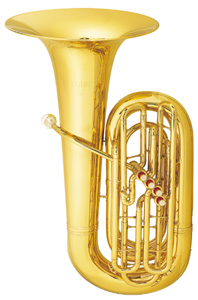
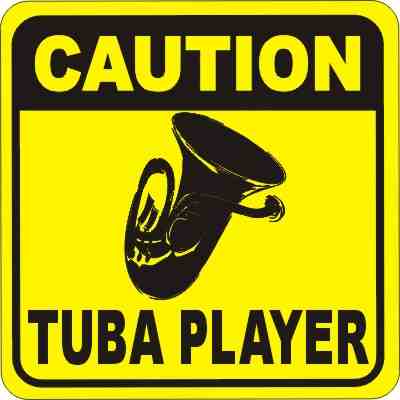 TONGUE
PLACEMENT
TONGUE
PLACEMENT
Remember: the large quantity of air produced by proper breathing will do you no good until it passes through the lips to make them vibrate. If the air is stopped or partially blocked in the process of blowing (often by the position of the tongue), the result will be one that is totally unsatisfactory.
Say the vowel "O" and feel the position of your tongue. The "O" sound causes the tongue to lie down flat in the bottom of the mouth, thereby allowing a free, unobstructed flow of the air stream. The "AH" sound can also put the tongue on the bottom of the the mouth, but, if overdone, can cause constriction in the rear of the throat, once again closing off the free flow of the breath. For this reason, the "O" sound is preferred.
If you say the syllable "TEE," feel how your tongue is arched up in the back. It will almost touch the top of your mouth in the back. If you play this way, the airflow is blocked, and you won't have a good tuba sound.
For the correct tongue placement for the beginning of a note, the player simply uses the syllable "TOH." Never allow the tongue to go between the teeth as it always causes a sloppy, thick attack. When it comes to correct tuba tonguing, JUST SAY "TOH!"
FORMING THE EMBOUCHURE
THE FIRST TONE
Take a deep breath, completely filling your lungs with air. You should open your throat wide, as if you are starting to yawn. If you hear a hissing sound while inhaling, it means that your tongue is arched too high towards the roof of your mouth, and will probably stay there (and choke off the air) when you start to play.
|
Tuba Tone Production Problems/Remedies | |||
|
SOUND |
SOUND |
CAUSES
OF |
REMEDIES |
|
1 |
Embouchure not formed
tightly |
Re-form embouchure,
"OH-OO- | |
|
Air stream restricted,
closed |
Emphasize "OH" to open throat, | ||
|
2 |
Embouchure formed too tightly, |
Loosen "grip" on the "tube" | |
|
Not enough air |
Review deep breathing, | ||
|
3 |
Embouchure not formed |
Grip the "tube" more firmly | |
|
Lips folding over teeth |
Re-form embouchure, check with ring, think "OO-OH-SQUEEZE THE TUBE | ||
|
4 |
Lips pinched completely together |
Don't "grip the tube" so much, re-form "OH-OO" | |
|
Not enough air |
Review your tongue position, | ||
This site is UNDER CONSTRUCTION
This site is UNDER CONSTRUCTION
This site is UNDER CONSTRUCTION
This site is UNDER CONSTRUCTION
This site is UNDER CONSTRUCTION
This site is UNDER CONSTRUCTION
This site is UNDER CONSTRUCTION